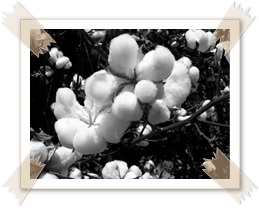GOOD COTTON = ORGANIC COTTON!
Organic cotton processing uses no harsh chemicals during cultivation or during the manufacture into yarn, fabrics, garments, bedlinen etc. Defoliants are NOT used to reduce the plant matter before, during and after picking of the cotton and are not used to clean the cotton. All processing means are biodegradable and free from harmful heavy metals, AZO dye, and other harmful substances.
Organature CERTIFIED ORGANIC COTTON products do not contain hidden harsh materials and are not fumigated.

The fabric is treated with means to preserve the natural characteristics of the cotton, and is kind to the environment.
After the cotton boll has been picked it is ‘ginned’; a process to remove seeds. This process also removes some of the plant matter. Further processing removes more of the plant particles; it is impossible to remove all. The result is that you may find the occasional dark spots in light colour fabrics and irregular dye marks in dyed fabrics.
The organic cotton filling in the Organature mattresses, quilts and pillows have only gone through early stage processes of ‘ginning’ and ‘carding’; carding being the process of teasing out the baled cotton into ‘fluffed up’ blanket.
It is impossible to remove all plant residue and this results in the dark markings which appear, particularly, in the quilts and pillows. When purchasing our organic products, there must be understanding that the client is fully aware of this ‘natural’ characteristic and accepts that these are not flaws and adds to the uniqueness of the product.
The TRUTH about CONVENTIONAL COTTON!
BAD COTTON = CONVENTIONAL COTTON!
You think that cotton is NATURAL! Don’t be misled!!!!
Cotton is a natural fibre, but…….just because it states “cotton” it is not always totally natural .There are more chemicals used on conventional cotton then on any other crop!
Chemicals are used to grow, harvest and process conventional cotton, they are used to make the fabric ‘easy care’,’ wrinkle free’,’ down proof’, etc.
THIS IS BAD COTTON!

The environmental effects of the CONVENTIONAL cotton industry are very destructive. The cultivation of CONVENTIONAL cotton is known for its intense application of powerful chemical pesticides and sometimes chemical defoliants.
Before being made into fabrics, garments, bed linen, towels etc. CONVENTIONAL cotton is usually treated with an array of chemicals, which are also used before and after picking the cotton to clean plant residue out of the cotton.
Chemicals are used to treat CONVENTIONAL COTTON fabrics for closing the weave, so that feather down and wool do not ‘creep’ through the outer covering material for quilts, also to make fabrics fire resistant and to enable the fabric to take heavy metal and AZO dye.
Furthermore conventional cotton clothing and bedlinen is treated with chemicals to make them easy care, non iron, wrinkle free.
Descriptions such as ‘handpicked’, ‘green’, and ‘unbleached’ and lately the use of the words “best practice” are often misleading and give no guarantee of an environmentally sound growing of the cotton or the weaving, processing and production of conventional cotton fabrics and garments.
Most chemicals applied during growing, processing and ongoing production of conventional cotton are permanently in the fabrics and there is growing evidence that these chemicals are affecting our health.
Australian labelling laws permit the use of a percentage of synthetic material, such as polyesters, in a product and the label can state “100% cotton” or “all cotton”.
Most quilts and pillows labelled cotton contain polyester mixed with the cotton wadding; some manufacturers use this to hold the cotton together and perhaps also to keep the price low. Others use thin polyester lining to enable manufacture of their quilts.
Imported products containing cotton; Australian Quarantine regulations state that cotton filled products imported into Australia must be fumigated or irradiated; this may include toys, bedspreads, duvets, comforters, quilts and pillows.